From the bustling forest floors to the tranquil wetlands, insects create homes in virtually every corner of Ontario’s diverse ecosystems. These remarkable creatures have mastered the art of adaptation, transforming everything from fallen logs to flowering meadows into thriving habitats. Whether you’re spotting iridescent dragonflies darting across marshlands, witnessing carpenter ants engineering complex colonies in dead wood, or observing monarch butterflies floating through pollinator gardens, Ontario’s insect habitats offer an extraordinary window into nature’s ingenuity.
Each habitat type – from urban gardens to old-growth forests – supports its own unique community of insects, playing vital roles in pollination, decomposition, and maintaining ecological balance. Understanding these habitats not only enriches our appreciation for these fascinating creatures but also helps us protect the delicate environments they depend on for survival. Join us as we explore the hidden worlds where Ontario’s insects make their homes, from the microscopic to the magnificent.
Common Insect Habitats in Ontario’s Parks
Forest Floor and Fallen Logs
The forest floor is a bustling neighborhood for countless insects, with fallen logs serving as nature’s apartment complexes. These decomposing wooden giants create perfect micro-habitats where beetles, millipedes, and various other crawling critters make their homes. Peek under a piece of bark, and you might discover carpenter ants building intricate galleries or colorful wood-boring beetle larvae creating artistic patterns in the wood.
Dead logs are particularly special because they provide different living spaces as they decompose. Fresh fallen trees attract bark beetles and wood wasps, while more decomposed logs host fascinating species like the striking blue-spotted salamander beetle. In spring and early summer, these areas become even more active as insects emerge from their winter hideouts.
Remember to gently replace any bark you lift, as these are vital homes for our six-legged friends!
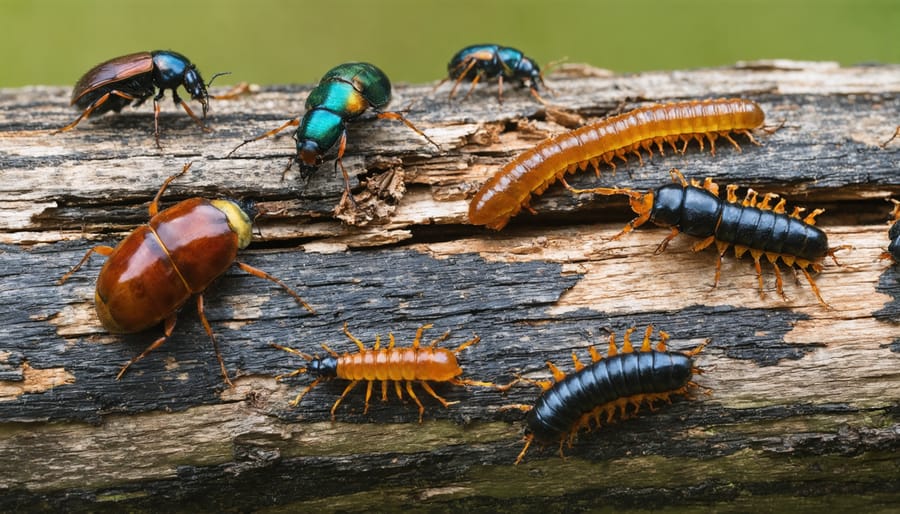
Meadows and Grasslands
Ontario’s meadows and grasslands buzz with incredible insect activity throughout the warm months. These open spaces are paradise for pollinators like bumblebees, butterflies, and flower-loving beetles, who feast on wildflowers like goldenrod, asters, and black-eyed susans. Grasshoppers and crickets create nature’s symphony, while beneficial predatory insects like praying mantises and ladybugs help keep pest populations in check.
Watch for the spectacular monarch butterflies that gather in these areas during their fall migration, particularly in late August and September. For the best insect-watching experience, visit meadows during mid-morning when the sun has warmed the air but before the afternoon heat sets in. Remember to tread carefully and stick to marked paths – these grassland habitats are delicate ecosystems where many insects make their homes in the soil or among plant stems.
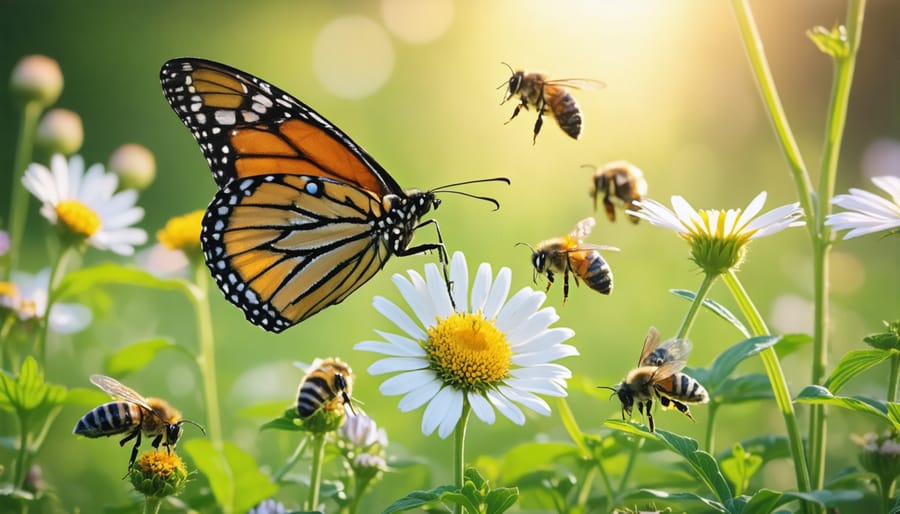
Wetland Areas
Ontario’s wetlands are bustling with fascinating insect life, from darting dragonflies to delicate damselflies skimming across pond surfaces. These water-rich environments create perfect conditions for various aquatic wildlife, including water striders that seem to dance on the surface and diving beetles that zip through the depths. Marshes, swamps, and bog areas provide essential breeding grounds for mosquitoes and mayflies, while cattails and bulrushes offer perfect perches for emerging insects. Keep an eye out for the impressive giant water bugs near the shoreline, especially during warm summer evenings. These wetland areas are most active with insect life from late spring through early fall, making them fantastic spots for nature photography and peaceful observation. Remember to wear waterproof boots and bring a good magnifying glass to spot smaller species hiding among the reeds!
Tree Canopies
Look up into Ontario’s towering maples, oaks, and pines, and you’ll discover a bustling world of insects living in nature’s high-rise apartments. The tree canopy hosts an incredible variety of creatures, from industrious carpenter ants building their wooden homes to beautiful Luna moths resting on branches during daylight hours. Leaf-munching caterpillars, including the Eastern tent caterpillar, create their silk nests in the upper branches, while busy bark beetles tunnel through the treetops. Spider webs stretch between branches, catching flying insects that venture into these elevated domains. In spring and summer, you might spot the brilliant metallic green of June beetles clinging to leaves, or hear the distinctive buzz of cicadas orchestrating their annual symphony from their lofty perches. For the best canopy-watching experience, bring binoculars and visit during early morning hours when insect activity is at its peak.
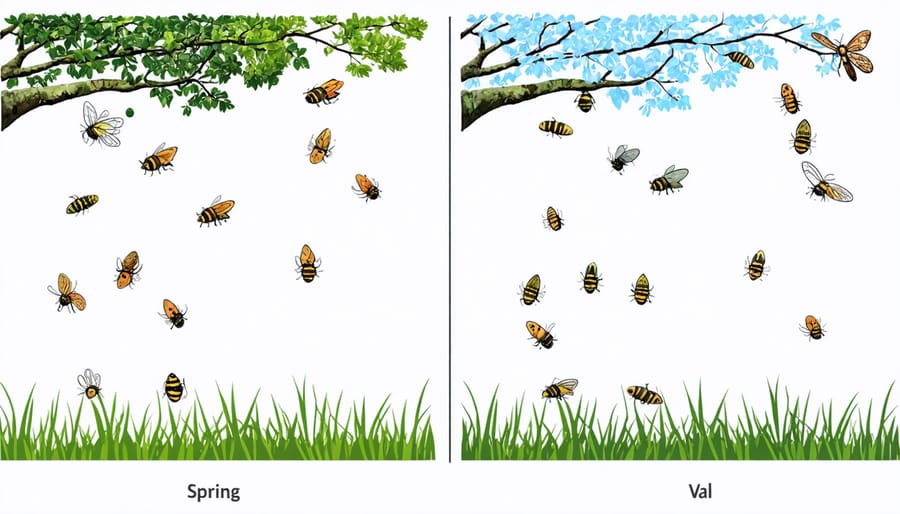
Seasonal Changes in Insect Habitats
Spring Emergence
As winter’s chill gives way to spring warmth, insects begin stirring from their winter hideouts across Ontario. Look for early-emerging butterflies like Mourning Cloaks and Eastern Commas in sunny woodland clearings, especially near birch and willow trees. You’ll find them basking on tree trunks or fallen logs during mid-morning hours.
Check damp areas under logs and rocks for ground beetles and centipedes, which become active as soil temperatures rise. Garden beds and mulched areas are particularly good spots to observe spring insects as they warm up. Listen for the first buzz of mining bees and watch for them creating nest holes in bare soil patches.
Near ponds and wetlands, water striders and whirligig beetles appear on the surface as ice melts. Rotting logs and stumps become busy highways for carpenter ants and termites establishing new colonies. For the best viewing opportunities, visit natural areas between 10 AM and 2 PM on sunny days when insects are most active.
Remember to tread carefully and avoid disturbing these creatures as they emerge from winter dormancy – they’re using valuable energy reserves to start their spring activities.
Winter Survival Spots
During Ontario’s harsh winters, insects employ fascinating survival strategies, finding shelter in surprising places. Many species seek refuge beneath thick layers of tree bark, where they can stay protected from freezing temperatures. You’ll often find clusters of ladybugs and stink bugs tucked away in these natural hideouts.
Dead logs and leaf litter create perfect insulated spaces for various beetles and moths. These decomposing materials not only provide shelter but also maintain relatively stable temperatures, much like nature’s own thermal blankets. Some butterflies, like the Mourning Cloak, actually survive winter as adults by nestling into tree cavities or wood piles.
Underground spaces become bustling winter apartments for many insects. Ant colonies dig deep below the frost line, while winter wildlife activity continues beneath our feet. Cricket eggs and beetle larvae find safety in soil cavities, waiting for spring’s warmth.
Look closely at garden mulch and you might spot dormant insects in what we call a diapause state – nature’s version of hibernation. Even your garden shed or garage might become an unexpected winter sanctuary for species like paper wasps and boxelder bugs seeking warmth.
Best Observation Spots in Ontario Parks
Frontenac Provincial Park Hotspots
Frontenac Provincial Park offers several prime locations for insect enthusiasts to observe diverse species in their natural habitats. The Doe Lake Trail, particularly around the wetland boardwalk, is a fantastic spot to witness dragonflies and damselflies darting above the water during summer months. Here, you’ll often spot the striking Eastern Pondhawk and the vibrant Blue Dasher.
The Big Salmon Lake area, with its mix of rocky outcrops and dense vegetation, provides an excellent environment for spotting butterflies like the Canadian Tiger Swallowtail and various species of moths. Early morning visits to this area are especially rewarding when insects are most active.
Around Arab Lake Gorge, the varied terrain creates unique microclimates that attract different insect species. The sunny clearings along the trail edges are perfect for observing grasshoppers and crickets, while the shadier sections host fascinating woodland beetles and moths.
For those interested in aquatic insects, the shallow bays of Buck Lake offer great opportunities to spot water striders and whirligig beetles. Remember to bring a magnifying glass for closer observation, and always maintain a respectful distance to avoid disturbing these delicate creatures in their natural environment.
Other Notable Park Areas
Beyond the main insect-watching hotspots, Ontario offers several hidden gems where you can discover fascinating insect life. The Eldred King Woodlands in York Region features extensive woodland trails where you’ll spot countless butterflies and beetles during summer months. Keep an eye out for the stunning Giant Swallowtail butterflies that frequent the meadow areas.
The Monarch Trail at Waterloo’s rare Charitable Research Reserve provides excellent opportunities to observe monarch butterflies and their caterpillars feeding on milkweed plants. Visit between July and September for peak butterfly activity.
Don’t overlook urban parks like Toronto’s High Park, where careful management has created diverse insect habitats. The park’s black oak savannah is particularly rich in native pollinators and fascinating ground-dwelling insects.
For dragonfly enthusiasts, the boardwalk at Mer Bleue Bog in Ottawa is a must-visit location. These ancient wetlands support over 23 species of dragonflies and damselflies, especially active on warm summer days.
Pro tip: Visit these locations during early morning or late afternoon when insects are most active. Remember to bring a camera with macro capabilities and wear earth-toned clothing to avoid disturbing the insects you’re observing.
Responsible Observation Tips
When observing insects in their natural habitats, it’s essential to practice responsible wildlife observation to protect these fascinating creatures and their environments. Start by maintaining a respectful distance – a good pair of binoculars or a macro lens can help you get close-up views without disturbing the insects.
Always stick to marked trails and existing paths to avoid trampling potential nesting sites or damaging vital microhabitats. If you’re lifting logs or rocks to look for insects, remember to gently place them back exactly as you found them, as these spaces serve as homes for many species.
Avoid using flash photography repeatedly, as this can distress insects and alter their natural behaviors. Instead, try visiting during optimal daylight hours when insects are naturally active. If you’re interested in night-time observation, use red-filtered lights which are less disruptive to nocturnal insects.
Never collect insects or remove them from their habitat unless you have proper permits for research purposes. Instead, document your findings through photographs or detailed notes. Consider using nature observation apps to record and share your discoveries while contributing to citizen science projects.
Remember to pack out what you pack in, and never leave behind any trash that could harm insects or their habitats. By following these guidelines, you’ll help ensure these incredible creatures continue to thrive in their natural environments for future generations to enjoy.
As we’ve explored the fascinating world of insect habitats in Ontario, it’s clear that these tiny creatures play a vital role in our ecosystem. From buzzing pollinators in meadowlands to mysterious fireflies in wooded areas, each habitat supports a unique community of insects that deserves our protection. By preserving these natural spaces and practicing responsible observation, we can ensure future generations will continue to experience the wonder of Ontario’s insect life. Whether you’re a budding entomologist or simply curious about nature, grab your camera and magnifying glass, and head outdoors to discover the incredible diversity right in your backyard. Remember to tread lightly, maintain a respectful distance, and share your discoveries with others to inspire more habitat conservation efforts in our beautiful province.

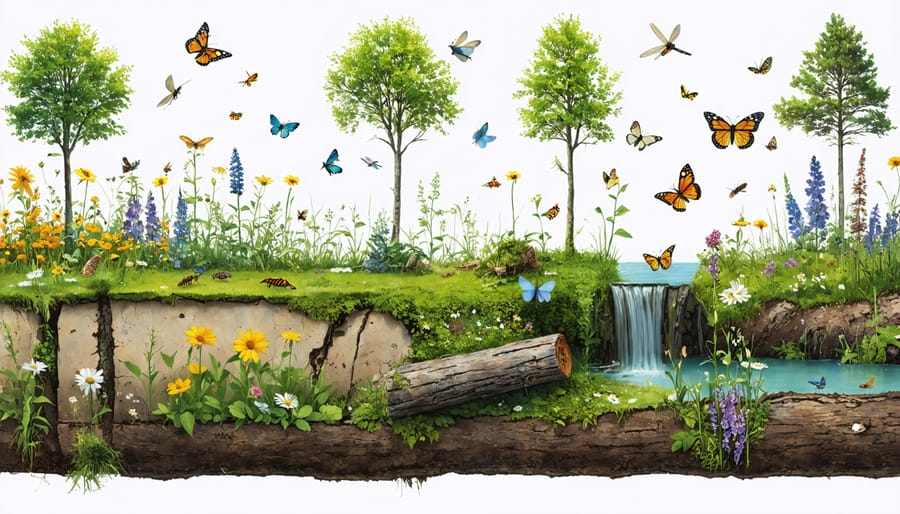
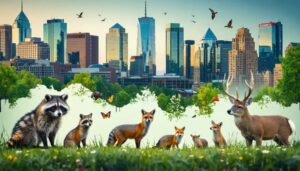











+ There are no comments
Add yours